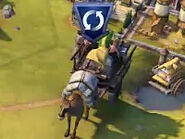The Trader is an Ancient Era civilian unit in Civilization VI.
- Attributes:
- Action: Establish a
 Trade Route Trade Route from this city to the destination city.
Trade Route Trade Route from this city to the destination city. - Action: Switch City (Instantly moves the Trader to another city in its owner's empire.)
- Ability: Create Roads along its Trade Route trajectory.
- Action: Establish a
Strategy
The Trader functions much like the Trade Convoy from Civilization: Beyond Earth: Rising Tide. It is able to establish a single ![]() Trade Route Trade Route over land or water (after researching Celestial Navigation) to any city in range, whether from your own empire or a foreign one.
Trade Route Trade Route over land or water (after researching Celestial Navigation) to any city in range, whether from your own empire or a foreign one.
Land route range is 15 tiles while sea route range is 30 tiles. These ranges, however, may be extended both by researching technologies, and by establishing Trading Posts in cities. Afterwards, passing through any city with a Trading Post refreshes the range of the unit, effectively doubling it.
What's more, a Trader automatically creates Roads as it travels! This makes it immensely important, especially in the early game when the Military Engineer isn't available yet.
The bonuses from the ![]() Trade Route Trade Routes created always apply to the city where the route started. For International routes (those going to another civilization's cities), most of the time the target city also gets some small bonus, although not nearly as big as the city of origin. Note that the resulting bonuses are different for each target city, and depend on a variety of factors.
Trade Route Trade Routes created always apply to the city where the route started. For International routes (those going to another civilization's cities), most of the time the target city also gets some small bonus, although not nearly as big as the city of origin. Note that the resulting bonuses are different for each target city, and depend on a variety of factors.
In the later eras, the land sprite for Traders changes from a cart to a cargo truck.
Historical Context
As soon as there were villages, there were traders. At first they used poor, dumb brutes – horses, mules, camels, llamas, men – as beasts of burden to carry gems, precious metals, spices and anything else that would turn a profit in a distant village. Every civilized, and many not, land was crisscrossed with trade routes, and these routes – such as the great Silk Road from China to the Middle East – shaped boundaries and civilization as surely as did any war or religion. In time, some traders took to the seas; many of the earliest written records are inventories of commercial goods in ships’ holds, and archaeology shows evidence of sea-going cargo ships in the Mediterranean and Red seas by the beginning of the first millennium BC. As longer voyages of trade were undertaken, cargo ship design was constantly revised; and the beasts of burden were replaced by truck convoys. But the same principle drives trade still … the human need to make a profit.

